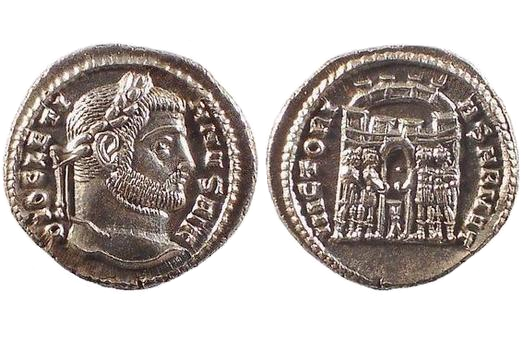
about ancient nomos
Ancient Nomos Art is a museum of galleries exhibiting ancient coins and ancient mint maps. The coin gallery displays the diverse art and history of hand-crafted ancient Greek, Roman, Byzantine, Persian and Medieval coinage. The ancient mints mapping gallery features Greek, Roman, Byzantine, Asia Minor and Medieval mint city regions and territories. Visitor's are welcome to explore, study and enjoy Ancient Nomos Art.

Imperial, Rome – 294 AD
Diocletianus
From Ancient Galleries

Obverse: Laureate bust of Diocletian as "Augustus" facing right with full beard.
Reverse: Four Tetrarchs sacrificing over tripod at eight-turreted campgate arch.
LEGEND
Obv. DIOCLETI – ANVS AVG, Laureate bust of senior tetrarch emperor Diocletian facing right. Rev. VICTORI – A SARMAT, Four tetrarch emperors sacrificing over tripod before the camp-gate archway, with an eight turreted stone enclosure above.
Emperor Diocletian, named Caius Aurelius Valerius Diocletianus, was born near Salona, Dalmatia of modest family origin in 245 AD. His practical intellect, autocratic leadership and military skills developed quickly and were recognized through military advancement after several successful campaigns under Probus, Aurelian and Carus. Following the deaths of the joint Roman rulers Numerian and Carinus, Diocletian’s army proclaimed him emperor in 284 AD. He soon concluded the empire was too large for one to govern and became the 1st emperor to formally divide the empire into east and west regions, with subordinate co-rulers in each region. His new governing structure was called a Tetrarchy, named for the two senior east-west “Augustus” emperors and two junior “Caesar” sub-emperors. This interesting coin coincides with the new governing structure and is also an example of Diocletian’s economic reforms that reintroduce a nearly pure 95% silver coinage in 294 AD. His currency reforms attempted to restore over 200 years of gradual Roman currency debasement. By the time of Serverus and Caracalla, silver fineness was lowered to 70% and then down to 50%. However, the greatest debasement reduced silver content to a mere 2.5% under Emperor Gothicus. Diocletian’s coinage was also given the new name of Argenteus and was intended to officially replace the standard Roman denarius. The coins obverse depicts a laureate bust of Diocletian facing right with legends for his name and title of Augustus. The coins reverse symbolizes Diocletian’s new governing structure and departs from traditional reverse imagery. Four Roman tetrarch rulers are seen for the first time standing together before a camp (or city) gate. The rulers two fold mission is to stand guard protecting entry into the camp and also conduct a ritual military sacrifice over a sacred tripod. A protective stone enclosure with eight lookout turrets stands behind the rulers.
DOCUMENTATION
Value: Argenteus. Metal: AR Silver. Weight: 3.40 grams. Mint: Siscia. Date: 294-295 AD.
Attribution: Roman Imperial Coinage, VI 34a; Jelocnik 4a; Pink, Silberpragung p.35; RSC 489†c.
Legend, Documentation and Attribution
